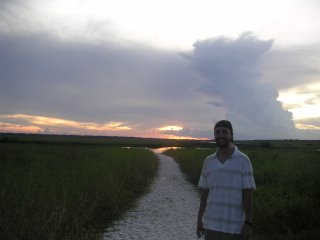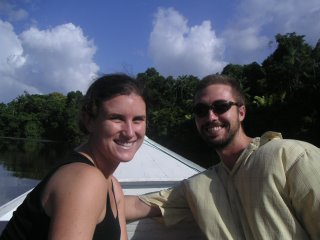The Most Productive Week in Peace Corps
Late in my week-long trip on the Pomeroon River with a group of American doctors visiting Amerindian villages, I was sitting on a dock overlooking the river, talking with friends. As I sat in the sun, relaxing after a hard morning of patients and HIV education, a bird passed overhead…. and pooped. The poop just narrowly missed my head and instead hit my finger. It was near miss to be sure. Things could have been much worse, yet it didn’t faze me much and the afternoon went on without incident. Looking back, this seems an apt metaphor for the week. It was full of near catastrophes from the beginning, each threatening to de-rail our participation in the trip. Yet, in the end, everything worked out and we had a great time, with just one exception.
So two Sundays ago, my Peace Corps friends Patty and Phillip and I met up with a group of twelve Americans. They were mostly pediatric residents at John Hopkins Hospital in Baltimore, with a few other doctors and nurses mixed in. They were a really nice bunch and very excited to get working in these Amerindian villages. The three of us Peace Corps volunteers, along with an HIV counselor/tester from an HIV/AIDS NGO on the Essequibo Coast, were really excited to accompany them (read: ride their coat-tails) because it offered a great opportunity to see many Amerindians in relatively remote areas. We knew they would come out to see the American doctors, so we were assured of large audiences to talk about HIV/AIDS, pass out condoms, and do HIV testing.
But things started out badly before we even met up. We got in contact with Karen, the head of American group, on Friday as we planned all the things we wanted to do – HIV talks, condom distribution, a baseline health questionnaire, and HIV testing. As we talked with Karen over the phone, it became apparent there had been a miscommunication, and she wasn’t aware that we wanted to go along with them. Crap. The solution was essentially to just show up and hopefully there would be room on the boat for us. Basically, Patty and I completely freaked out after this conversation. We had been working all day preparing for this trip, not to mention being very excited for it. Now we were unsure if we could even go. Patty had spent all day revising a health questionnaire, making a data sheet for it, and testing it on me. I had spent a few hours picking up a 50 pound box of 7200 condoms to bring out there. We were both about to cry if we didn’t get to go.
So fast-forward back to Sunday – we get on the boat. Or more accurately, we got on a second, smaller boat. The doctors were carrying all their medical supplies, so we needed a second boat anyways. Phew. So we first went to Wakapoa, a community of about 2000 Amerindians spread among three major islands surrounded by a savannah marsh, all down a creek that comes off the Pomeroon River. It is a completely gorgeous place. We spent two full days there, giving HIV talks, distributing condoms, and testing people. The doctors saw probably about a hundred people a day, including many school children.
This was essentially how the whole week was – they would see people, then send them to us in the back, where we would do one-on-one HIV education and see if they wanted an HIV test. Then our HIV counselor/tester would do her thing. It was a very efficient and effective process we developed. As I’ve talked about before, stigma and discrimination about HIV/AIDS is a big problem here. If we had gone ourselves and announced that we were doing HIV education and testing, people would not have come for fear of being seen and labeled HIV positive. But the doctors gave us a cover. People were sometimes told they were being sent to us for “health education.” But as soon as they got alone in the room with us and were told we were talking about HIV, people were very receptive. I didn’t have one person who wasn’t interested and wanted to walk out. I think that because it was kind of secretive, people were willing to listen – eager, even. We had very few people decline an offer to be tested for HIV. We tested people ranging from 74 year olds to 11 year olds, most of whom were just more curious than anything else. Overall, we tested over a hundred people and, somewhat surprisingly, got no positives. Statistically, this is kind of weird, considering the HIV rate is around 5% and estimated to be even higher in these Amerindian communities. However, there are a few reasons we got no positives. First, we tested a bunch of 11 to 15 year old school children. Obviously this is not a high risk group, though I definitely talked to more than one twelve year old who was having sex. Secondly, we weren’t able to test very many 18-35 year old men who work for months in mines in the interior. These are the highest risk group in Guyana in many ways. They leave their families for months at a time, going to remote places with lots of sex workers. They don’t like to wear condoms, or, as I found out talking to one guy, condoms can cost up to US$5 for one in this areas. We did test some of their wives, many of whom told me they don’t trust their husbands and have already gotten STD’s from them when they come back from the interior. These women would have been a kind of secondary sign of a bad HIV rate in the communities. So we weren’t able to test many from the high risk group, and we “padded” our numbers with low risk people. Hence, no positives.
This is not to say we didn’t get our fair share of people who easily could have been positive. One guy had had unprotected sex with twelve different girls… in the past three months! Obviously, he was a little scared. He tested HIV negative, though he could be in the Window Period (when you are actually HIV positive but don’t have enough anti-bodies in your blood for the test to result in a positive; this can last anywhere from three weeks to six months, depending on the person).
So besides the work, it was still a great time. There were constant questions about transportation, food, and lodging, but we survived it all. We Peace Corps people did have to skip one community because it was too expensive for us to get there and back, but otherwise we went everywhere the doctors went. In Wakapoa, we slept outside in hammocks with mosquito nets. It was nice to wake up to a great sunrise each morning. On the other hand, each night I woke up freezing around 2AM and had to wrap a damp towel around my legs as a blanket. So that wasn’t too nice. And I’m not mentioning the roosters that seemed to practice their vocal cords throughout the night, anticipating the sunrise. Or the first night, when a dog was making the most horrible sound in the world, a sound I described as if it were being taken advantage of by a monkey. But otherwise, no complaints.
When we were in Kabakaburi, we stayed by a Peace Corps volunteer, which meant beds! Unfortunately, the mosquitoes there were like the T-1000 in the Terminator movies – they somehow could go through our mosquito nets. So both nights, I woke up with a few hundred mosquitoes inside my net. Nothing is more annoying in the world than slowly descending into sleep, only to be rudely pulled back to reality by the high-pitched buzzing of a mosquito circling your ear. I wanted to kill each and every one of those little bastards.
Kabakaburi was beautiful but different from Wakapoa. It was a series of houses and compounds along the shore of the Pomeroon River. This was also how St. Monica and Karawab were set up. These were all beautiful places. In addition, they were much closer to the Peace Corps stereotype. Semi-remote villages, they didn’t have electricity running water. People drank rain water they caught in huge tanks. They bathed, did their laundry, and washed their dishes in the river. This was much closer to what I thought I was signing up for when I joined Peace Corps. This is not to say that I live an American life here without any challenges. I just don’t usually have to worry about electricity or running water. That’s all.
Anyways, we spent a total of six days on the Pomeroon River. It was fantastic. I felt incredibly useful the whole time. I felt like I finally did something in Peace Corps. Patty and I joked that this will have been the most productive week for us during our first year here in Peace Corps. And we’re probably right. I don’t know if that’s because we had such a great week or because we feel so useless sometimes at our sites as we still try to figure out what exactly we should do. I’ll let you know when I figure the answer out.
Make sure you check out the pictures right after this post. And I need to write again, because I didn't even talk about my HIV conference on Abstinence and Being Faithful. That was interesting, to say the least. I also had potentially the two best nights of my life in Guyana during that conference. I'll post about that stuff jus' now...


